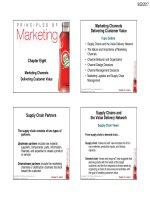Lecture Entrepreneurship: Chapter 8 - Zacharakis, Bygrave, Corbett
Bạn đang xem bản rút gọn của tài liệu. Xem và tải ngay bản đầy đủ của tài liệu tại đây (396.33 KB, 11 trang )
THE BUSI NESS
PLANNI NG PROCESS
Chapt e r 8
Zacharakis, Bygrave and Corbett, Entrepreneurship, New York: Wiley,
2017 ©
1
You Need a Business Plan
q
It is a small investment in time and cost when compared to the time
and cost of starting a business.
q
It forces the entrepreneur to think critically about all aspects of the
business venture.
q
It can later be used as a benchmark to monitor the progress of the
business.
q
Describes the details of how you will exploit your opportunity
q
Creates opportunities to raise critical questions …and to research
and find answers
q
Relatively small investment in time and cost
“Plans are useless, but planning is indispensable”
- GEN Dwight D. Eisenhower
Zacharakis,
Zacharakis,
Bygrave
Bygrave
& Corbett,
and Corbett,
Entrepreneurship,
Entrepreneurship,
New York:
New
Wiley,
York: Wiley,
2017©
2017 ©
Business Planning is a Continuous
Process
q
q
q
q
Begins when you start thinking about a new venture
Accumulate a critical mass of learning
Organize summary information to share your idea
and to identify gaps
Focus on critical aspects of the business model
Keep in mind—the business plan is a “living
document.” It will continue to evolve as you
progress.
Zacharakis,
Zacharakis,
Bygrave
Bygrave
& Corbett,
and Corbett,
Entrepreneurship,
Entrepreneurship,
New York:
New
Wiley,
York: Wiley,
2017©
2017 ©
Your Business Plan as a “Story”
Key takeaways for your business are found in the
process of developing a well-written story
q How will stakeholders interpret your plan?
q A tagline creates a unifying plot line that organizes
your thinking
q Stick to the “general format” of business plans
q
“A business plan is the persuasive, yet concise,
story about where the company came from,
where it’s going and how it will get there.”
Shane Eten, Founder & CEO BluCarbon
Zacharakis,
Zacharakis,
Bygrave
Bygrave
& Corbett,
and Corbett,
Entrepreneurship,
Entrepreneurship,
New York:
New
Wiley,
York: Wiley,
2017©
2017 ©
Business Plan Format –
Keep it Simple!
Zacharakis,
Zacharakis,
Bygrave
Bygrave
& Corbett,
and Corbett,
Entrepreneurship,
Entrepreneurship,
New York:
New
Wiley,
York: Wiley,
2017©
2017 ©
A Business Plan is Judged by
Its Cover Create a Good One!
The Cover
q An “Eyecatcher”
q Control Distribution
q Disclaimer
q Simple…but
Important Details
Clearly Identify
q Company Name
q Tagline
q Contact Information
q Date of Publication
Imagine the frustration of an excited potential investor who can’t
find your contact information – that plan will be rejected.
Zacharakis,
Zacharakis,
Bygrave
Bygrave
& Corbett,
and Corbett,
Entrepreneurship,
Entrepreneurship,
New York:
New
Wiley,
York: Wiley,
2017©
2017 ©
Draft an Executive Summary
q
q
q
q
q
Most Important (and Exciting) Section
Write it after you have researched your venture
Capture the reader’s attention – the HOOK
Highlight the potential of the Opportunity
Provide compelling information on:
ü
Description of the Opportunity
ü
Competitive Advantage
ü
Business Concept
ü
Business Model & Economics
ü
Industry Overview
ü
Team & Offering
ü
Target Market
ü
Financial Snapshot
Zacharakis,
Zacharakis,
Bygrave
Bygrave
& Corbett,
and Corbett,
Entrepreneurship,
Entrepreneurship,
New York:
New
Wiley,
York: Wiley,
2017©
2017 ©
Your plan should cover 9 main
areas
Zacharakis, Bygrave and Corbett, Entrepreneurship, New York: Wiley,
2017 ©
Three Essential Types of Business Plans
q
q
q
Operational Plan
q Internal use
q Often 80+ pages
Formal Plan
q External use
q Roughly 25 to 40 pages
Expanded Executive Summary
q for enticing interested stakeholders
q In lieu of a full business plan
q Typically 7 to 10 pages
Zacharakis,
Zacharakis,
Bygrave
Bygrave
& Corbett,
and Corbett,
Entrepreneurship,
Entrepreneurship,
New York:
New
Wiley,
York: Wiley,
2017©
2017 ©
Presentations should be direct
•
Should be able to communicate your
business opportunity in 10-12 slides
1.
Cover page w/ product picture
2.
Opportunity description
3.
Illustration of how your product solves a
problem
4.
Details as needed
5.
Competition overview
6.
Entry and growth strategy
7.
Overview of business model
Zacharakis, Bygrave and Corbett, Entrepreneurship, New York: Wiley,
2017 ©
10
Recap
q
q
Business planning allows the entrepreneur to
better anticipate questions and gaps instead of
reacting to them
Entrepreneurs can get feedback from experts,
including investors, vendors and customers
Zacharakis,
Zacharakis,
Bygrave
Bygrave
& Corbett,
and Corbett,
Entrepreneurship,
Entrepreneurship,
New York:
New
Wiley,
York: Wiley,
2017©
2017 ©









